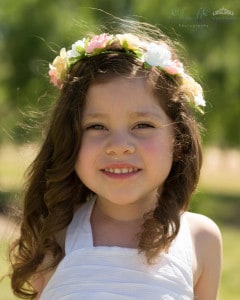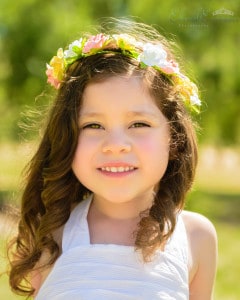Sometimes, for whatever reason, you end up taking pictures in bright afternoon sun. It happens and although it may not be ideal due to bright harsh light and strong shadows it can be done successfully. Here are a few tricks.Of course Golden Hour is the absolute best (and easiest) time of day to take great pictures from a lighting perspective. Golden Hour is either the hour right before the sun sets or the hour right after the sun rises. During this time, the sun is low in the sky, which lends itself for easily executable beautiful haze, sun bursts, and soft even golden light. The light is beautiful at almost any angle and there is no worry for harsh light or dramatic shadows. But what if you are at a family event and it takes place in the middle of the day? Surely you still want nice photos, right? Of course, and although you may have to think through your lighting strategy a little more methodically, great light can still be achieved. So what is the strategy for taking beautiful pictures in bright harsh mid-day sun light? Please read on for my 5 tips to shooting in bright sun light:
1.) Backlight your subject
I will usually choose to backlight my subjects no matter what light I am shooting in … I just love dreamy backlit photos. Although, I am not sure I would classify mid-day sun as “dreamy”. Nonetheless backlighting is still a good strategy. In fact, if I am in an area where there is no shade or spotty shade, I will opt to place my subjects directly in the sun just with their backs to it. Backlighting will give your subjects that nice bright glow behind them and light up the rim of their hair. The secret to doing this successfully is literally to ensure that the sun is directly behind them so no harsh shadows fall onto their face. Now there is one problem to backlighting in bright bright sun. Since your subject is blocking the sun, their face will be dark. To combat this you could fix in this post … or you could bounce some light into their faces to brighten them a bit. reflects crisp clean light back into the subject’s face and will often be just enough light to capture a nice catchlight. Unfortunately, there was one session I where I wore a hot pink shirt and when I looked through my images on the computer I discovered an unflattering reddish tint reflected onto my subject’s face in every close up picture. Another reason for wearing white or even using a reflector is for backlighting. Because all the light is coming from behind your subject, faces can be a little too dark and bouncing a little light back up into your subject’s face can help solve for this.
2.) Watch shadows
I have two recommendations on watching shadows. The first is in relation to the tip above: Backlight your subject. Rather than looking directly into the sun and blinding yourself to determine its direction, look at where the shadows are being thrown. For backlighting, I simply check to ensure my subject’s shadow is directly in front of them. My second recommendation is to be watchful of shadows cast on your subject’s face. Shooting in bright light can be challenging as everything casts a shadow and in most cases the shade is spotty at best. Position your subject directly in the light with their backs to the sun. I recommend skipping ‘shade scouting’ all together as this could lead to spotty shadows on your subject’s face. Trust me, you are better off in the sun!
3.) Move slightly
Small movements on your part as the photographer can make a big difference in how and where light is reflecting off your subject and into your camera. When I see a stream of light or a shadow I think is unappealing, I change my angle….slightly. This can be as simple as tilting the camera up or down or me standing on tip toes or squatting. Little movements can change your picture drastically. If I have the perfect angle and still have unattractive light cast on my subject’s face then I will ask them to move their head away from the light slightly so that the light falls into the outlines of the client’s hair and not on his or her face.
4.) Shoot in matrix (Nikon) or cumulative (Canon) mode
Preserving the detail in the sky in a backlight photo is almost impossible … almost. I have learned a few tricks that help with this problem most of the time. If there is sky in my photo, I will change my metering mode to matrix in Nikon or cumulative in Canon. Matrix or cumulative measures the light from the entire frame and adjusts the exposure bar based on that measurement. In addition to changing my metering mode, if there is sky in the photo, I will also choose to underexposed my picture by a third. The objective is to find a happy medium between properly exposng the subject and properly exposing the sky. This means that although my sky will still be bright, it won’t be completely blown out and I can bring back some of detail and the color in post-processing. It also means, unfortunately, that my subject’s will be slightly too dark and I will also have to also adjust them in post-processing. Usually I like to get things perfect in camera but in this scenario, unless you are using fill flash or a reflector, an exception will need to be made. In the below picture, the SOOC (straight out of camera) image on the left is a little underexposed specifically on the little girl’s face. The second image on the right is the edited version. As you can see we brought up the exposure on her face a little in post-processing. Both Lightroom and Photoshop allow you to adjust exposure in one key area only as opposed to applying the effect to the whole image, and that is exactly what we did here.
5.) Wear white and / or use a reflector
I prefer to a wear a white shirt during photo sessions for two reasons. The first is if I am standing close enough to my subject, light can be reflected off me onto my subject and the color white does not cast an unflattering color. Rather it reflects crisp clean light back into the subject’s face and will often be just enough light to capture a nice catchlight. Unfortunately, there was one session I where I wore a hot pink shirt and when I looked through my images on the computer I discovered an unflattering reddish tint reflected onto my subject’s face in every close up picture. Another reason for wearing white or even using a reflector is for backlighting. Because all the light is coming from behind your subject, faces can be a little too dark and bouncing a little light back up into your subject’s face can help solve for this.



